Abstract: This paper discusses the diversity of ramen in Japan by focusing primarily on regional delicacies, while also showcasing the broad array of ramen dishes worldwide. I breakdown what the ramen noodle is, the components of the dish (i.e. broth and noodle type), as well as the various condiments that uniquely define the region the ramen noodle dish is from. Also, I provide examples of how the ramen has evolved over time by describing unique ramen dishes created outside of Japan. My primary goal in this paper is to bring awareness to how the Japanese ramen various throughout the country, and how it has changed, adapted, and evolved over time.
It’s a quarter past seven as I stare at my computer screen, my fingers struggling to type out the first words of my final research paper. The thoughts in my mind wander, drifting away from the prompt typed on the sheet of paper lying motionless next to me. My stomach is alive, gurgling and grumbling. I am starving. I push back my chair and plod my way over to the kitchen table. Grabbing my car keys, I make my way to the garage and sink into my car seat. Swiping right to unlock my phone, I punch in the address to Hajime. My five senses are awakened as I step into this umami palace. The waitress catches my eye and motions me over to my usual spot in the corner. No menu needed; I know exactly what I want. Closing my eyes, I take in the aroma of the atmosphere, the sizzling of the teppanyaki grill, and the hollering of the bachelors as they down sake shots. Excuse me sir, may I? Opening my eyes, I am greeted by the most beautiful, divine, piping hot bowl of my all-time favourite comfort food…Ramen. As I sit there, face full of hot savoury noodles, I remain ignorant to the tumultuous history that brought this very dish to my table.
Contrary to popular belief, Japanese ramen is not in fact native to Japan. Like noodles and pasta from all over the world, they originated from one place: China. The Japanese were introduced to the noodle in a rather violent, and politically charged manner. Prior to the Meiji Restoration in 1868, Japan’s doors to the outside world were firmly shut. However, it was during the period between 1868 and 1912 that Japan experienced major political, economic and social change, following the death of the feudalistic military government (Kushner). As their doors were opening to foreign culture, the Japanese saw the rise of Chinese migrants in their cities. These migrants did not come empty handed or without gifts. The Japanese port cities of Yokohama and Nagasaki were introduced to shina soba from the Chinese who began selling this unique noodle to local workers. In 1910, the first noodle restaurant opened its doors, selling this newly introduced shina soba (Kushner). It rapidly grew in popularity, especially amongst workers as it was a relatively cheap and filling dish. However, during World War II, food restrictions drastically impacted the selling of shina soba in Japan.
Following a post-war economic boom, a saint-like individual by the name of Momofuku Ando invented the antidote to starvation, instant-noodles (Wei). During this economic boom, people were working overtime to keep up with the fast pace industrial expansion. The need for fast, convenient, and filling food was at an all-time high, and Momofuku’s instant noodles was the answer to their prayers. While no longer being called shina soba, “ramen” was rising in popularity again. As early as the 1980s, local ramen dishes were readily available, and in 1994, the first ramen museum open its doors in Yokohama (Japan Centre). Nowadays, ramen dishes are available in every city, town, and village in Japan. Similar to Italian and Chinese culture, each major region of Japan boasts its own unique take on this widely globalised dish. In this paper, I aim to highlight the diversity of ramen in Japan by focusing primarily on regional delicacies, while also showcasing the broad array of ramen dishes worldwide.

Growing up, I had the great privilege of traveling to Japan with my family, and anyone who has every visited Japan or interacted with Japanese people, knows how much ramen means to them. Ramen to the Japanese, is on par with ‘pasta al pomodoro’ for Italians, or ‘Beijing soybean paste noodles (Zha Jiang Mian)’ for the Chinese. In short, ramen is their national dish and a cultural icon (Japan Centre). Visiting Japan, and eating at various ramen-ya, I could feel the soul of Japan in each bite. It was truly a magical feeling. When I was younger, my father’s closest Japanese friend taught me the secret to ramen in Japan: the broth. Throughout Japan, ramen broth was classified into four separate categories: shio (salt), shoyu (soy sauce), miso (fermented bean paste), and lastly, tonkotsu (pork). In addition, the broth can also be classified by its heaviness, soup base, and seasoning.
Heaviness can be broken up in to kotteri (rich) or assari (light). A richer broth is usually thick, opaque, and filled with emulsified fats, vitamins, and proteins. What I found rather fascinating is that, “opaque white bone broths are also known by their transliterated Chinese name, paitan” (Kenji). On the other hand, lighter broths are thinner and clearer, and are usually mixed in with vegetables and fish. The soup base is prepared by simmering the main ingredients, which can range from animal bones to sea kelp or dried seafood (Kenji). That delicious aromatic smell that we love so much is a result of the infusion of onions, garlic, scallions, and mushrooms. Seasoning is one of the most important aspects of a ramen dish and is the primary source of salt used to flavour the ramen soup. When I was in Japan, I noticed that a few restaurants would opt out of mixing the seasoning directly into the soup base, and instead add it to each individual ramen dish per the customers requirements and desires. One of the most popular and oldest forms of seasoning is shio or sea salt. In Hakodate, a Southern Japanese city, many of its local dishes such as shio ramen are heavily influenced by Chinese traditions and Chinese style noodle soups. Another ramen seasoning that I personally find delicious is called shoyu. This type of seasoning is prevalent in the Kanto region of Central Japan. While it is now commonly paired with creamy Tonkotsu pork broths, traditionally shoyu seasoning would have been mixed in with clear to brown chicken or seafood broths. Originating from Hokkaido, and only gaining popularity in the 1960s is miso. Being one of the youngest ramen seasonings is also one of the most popular, and being from a colder region like Hokkaido, it boasts a bolder and heartier robust seasoning.

While both the broth and seasonings are vital components of ramen dishes throughout Japan, the most important aspect of the dish is the ramen noodle itself. I have eaten my fair share of ramen noodles throughout my life, and while this may be completely inaccurate, I believe there are more types of noodles in Japan than there are shapes of pasta in Italy. The ramen noodle itself can come in various forms, some of which include straight, thin, narrow, thick, wavy, wide, or flat. In order to pick what type of noodle they want to use, chefs look for its, “bounciness, ability to cling, and their texture in the mouth, searching for a noodle that interacts harmoniously with the soup in the bowl” (Kenji). Fun fact: I was once told that a piping hot bowl of ramen noodles should not take any longer than 7-15 seconds to make its way from the kitchen to the dining table otherwise the meat broth will lose its unique umami flavour.
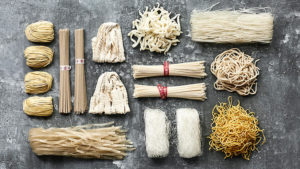
In order to continue our exploration of the various kinds of ramen dishes across Japan, and eventually, across the globe, we must first define what a ramen noodle actually is. Similar to how other noodles and pasta is made, ramen noodles are made with wheat flour, salt, water, and kansui. Kansui is an, “alkaline water which gives the noodle their characteristic bounce and their yellowish hue” (Kenji). Nowadays, there are three types of noodles globally: Fresh, Dried and Instant. Fresh ramen noodles are very common in many up-scale restaurants around Japan and are made from scratch. They are quite chewy in texture which gives it a far more authentic taste as compared to dry and instant ramen noodles. Fresh noodles are also usually thin and straight and can be found in many tonkotsu broths. The reason why chefs opt to use thin and straight fresh noodles in tonkotsu broth is because the noodles do an effective job at clinging together and holding the soup in through a capillary action, which delivers, “plenty of hearty pork flavour with each slurp” (Kenji). On the other hand, fresh wavy noodles are best paired with miso broth as their waves are better designed to hold the miso’s nutty bits of fermented bean (Kenji). Trying to say which type of ramen, straight or wavy, is the best is a rather foolish task, which is almost like trying to say that spaghetti is inherently better than linguine or tagliatelle.
While one would find an abundance of fresh ramen noodles in restaurants across Japan, dried ramen noodles are primarily reserved for at-home cooking and are made by drying fresh uncooked noodles. Dried ramen noodles can also be found in many ramen packets in supermarkets across Japan. The thinner and straighter dried ramen noodles are, the better they taste, albeit the fact they are far oilier in texture than fresh noodles (Schweitzer). The third, and most global type of ramen noodles, is instant noodles. As a college student, I can fully relate to the craze behind instant noodles. Not only are they extremely convenient to prepare, but they burst with flavours, and are relatively healthy. In 1958, Momofuku Ando blessed the world with this genius invention, which completely revolutionized how people view the Japanese ramen.
Japan is made up of over 6,800 islands along the Pacific coast, with the five main islands being Hokkaido, Honshu, Shikoku, Kyushu, and Okinawa. Each island or region boasts its own unique twist on Japanese ramen, and there are so many variations of ramen that classifying each unique twist would be almost impossible. However, the three regional Japanese ramen variations that I was taught to be the most important are Tokyo-style ramen, Sapporo ramen, and Hakata-style ramen.

Tokyo-style ramen is made predominantly with curly, wide noodles in a pork and chicken broth. When I was in Tokyo, I found many ramen broths that are heavily flavoured with a regional delicacy: dashi. Dashi is a, “broth made from dried smoked bonito flakes and sea kelp” (Kenji). What I find fascinating is that the dashi broth from the Tokyo-style ramen is actually a mix of traditional Chinese-style soup broths with broth from traditional Japanese buckwheat soba noodles which is very light yet rich in flavour. The deliciousness of Tokyo-style ramen comes from the generous portion of shoyu seasoning, and is traditionally served with chashu (pork), kamaboko (white and red fish cake), egg, and preserved bamboo shoots.
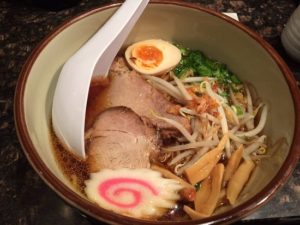
On the other hand, Sapporo ramen originates from Japan’s most northern province of Hokkaido and is one of the most influential styles of ramen in Japan. Usually Sapporo ramen is prepared with a very rich, and hearty, chicken, fish, or pork broth. What makes it especially unique is that it is also flavoured with akamiso, which is a red soybean paste. The addition of the red soybean paste gives Sapporo its rich flavour, which makes it the perfect dish for the cold weather up North. The region of Hokkaido is known for its massive vegetable and dairy farms, as well as several fishing ports. Utilising the geography and vegetation that Hokkaido offers, chefs specifically prepare Sapporo ramen with ingredients native to this Northern Region. As a result, this delicious dish’s umami is enhanced with the addition of stir-friend bean sprouts, cabbage, sweet corn, roasted scallops, and butter (Kobi’s Kitchen).
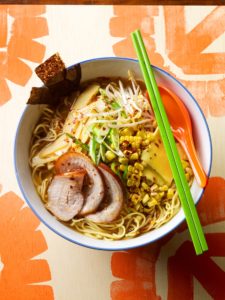
Hakata-style Tonkotsu ramen may be one of the most unique ramen dishes in the entire world. Originating from the warmer Southern Japanese island of Kyushu, this dish is commonly referred to as the standard of tonkotsu ramen. This type of broth is seasoned well with shio in an effort to preserve the milky white colour of the soup (Kenji). Usually Hakata-style ramen is served with chashu, wood-ear mushroom, beni-shoga (a type of Japanese pickle), and spicy mustard greens. Chefs who make this style of ramen are famous for their use of bold flavours and textures that they believe can stand up well to the intense pork flavour.
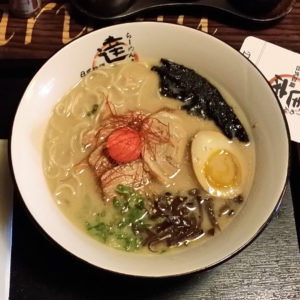
All these types of ramen dishes just go to prove how diverse Japanese ramen culture really is, and how similar to Italy and China, each region in Japan due to their cultural, societal, and agricultural characteristics, produce a unique twist and style of ramen noodles. As we all know, ramen is stereotypically that cheap fast food dish you order at odd hours of the night to satisfy night-time cravings, but it also is a highly complex pillar in Japanese society. A simple bowl of ramen represents the political, cultural, and culinary importance of the Japanese, and as such it is often considered to be a national cultural icon (Goulding).
In 2004, tourism in Japan skyrocketed, and as a result, the ideology behind a ramen dish transformed to be inclusive of various elements of global culture. One such example is of Ivan Orkin; a famous ramen aficionado who spent years in Tokyo understanding and learning the history and craft behind ramen. In his NY ramen restaurant, Ivan put together a speciality dish called Maze-men. Of the reviews and articles that I have read surrounding this dish, many have noted that it is quite similar to abura soba, however he adds his own unique Italian background twist by adding an egg and bacon. Mixing it all together forms this beautiful sauce, almost like a Japanese carbonara (Kenji).
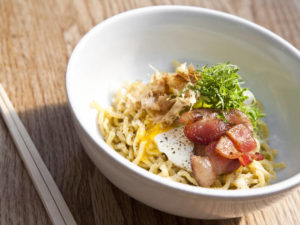
One of the most diverse, and creative takes on ramen, which I have in fact have had the great pleasure of eating is located at Yuji Ramen in New York. Once again, we see the cross culturalism of Italy and Japan coming together to produce a dish like no other. The basic premise behind this dish is that the chef uses Japanese ramen-style alkaline water dough, but instead of making them into the ramen noodle strands we have grown accustomed to, the chef actually shapes the dough into Italian pasta shapes (Kenji). Not only are the noodles Italian-Japanese, but the beautifully delicate sauce is textually inspired by Italian sauces but seasoned with Japanese ingredients and techniques. The result is a fusion ramen dish that ties in the best of both Italian and Japanese noodle/pasta cuisines to create a scrumptious dish like squid bolognese ramen orecchiette.
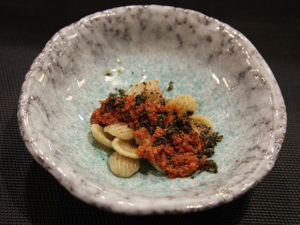
Ramen shops are no longer confined to the tight geographic and political boundaries of Japan. Nowadays, one can find a Japanese ramen restaurant in every major city in the world. What once started off as a cheap, immigrant dish has now catapulted itself into every college student’s dorm rooms. Everyone around the world shares their love for ramen as the ultimate comfort food. Now as this iconic Japanese symbol of cultural identity evolves and tailors itself to the specificities of cultures and societies, the ramen that was once loved by merchants in Imperial Japan, is now loved by billions all over the world.
Works Cited
Goulding, Matt. “Super Noodles: the Rise and Rise of Ramen.” The Guardian, Guardian News and Media, 22 Feb. 2016, www.theguardian.com/lifeandstyle/2016/feb/22/the-rise-and-rise-of-ramen-noodle-soup.
“Japanese Ramen, How to Make and Different Types.” Japan Centre, www.japancentre.com/en/pages/62-ramen.
J. Kenji. “Guide to Ramen Varieties.” Guide to Ramen Varieties | Serious Eats, Serious Eats, 18 Apr. 2019, www.seriouseats.com/2013/09/the-serious-eats-guide-to-ramen-styles.html.
Kushner, Barak. Slurp!: a Social and Culinary History of Ramen – Japan’s Favorite Noodle Soup. Global Oriental, 2012.
Schweitzer, Sharon. “The Cultural Significance of Ramen.” HuffPost, HuffPost, 27 Oct. 2017, www.huffpost.com/entry/the-cultural-significance-of-ramen_b_59f33f8ce4b06acda25f4939.
Wei, Clarissa. “An Illustrated History of Ramen.” First We Feast, First We Feast, 1 June 2018, firstwefeast.com/eat/2015/07/illustrated-history-of-ramen.
